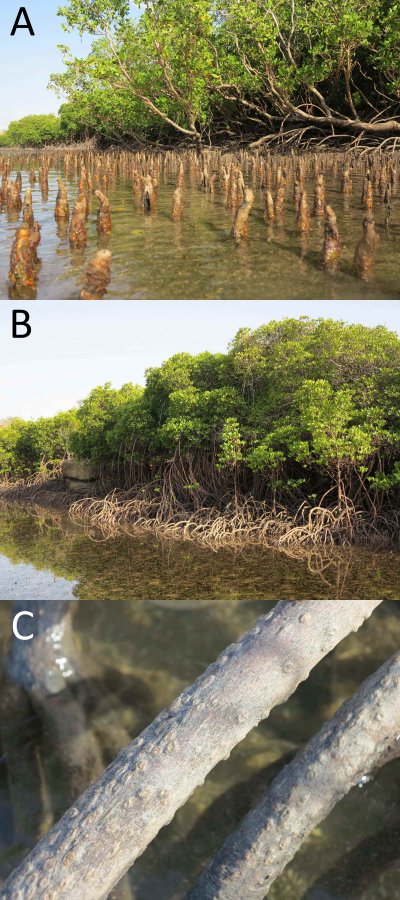Waterlogging tolerant species tend to develop larger adventitious root systems than intolerant species, and these roots contain aerenchyma. The initiation and outgrowth of adventitious roots has been studied in wetland species such as rice and Rumex palustris; accumulation of ethylene appears to be the primary signal for this response, and auxin and H2O2 are also involved in the downstream signalling cascade (Visser et al. 1996; Steffens and Sauter 2009).
Newly-formed adventitious roots with aerenchyma can grow into anoxic waterlogged soil, but in many cases adventitious roots also grow close to the soil surface, or when floods submerge a significant portion of the stem they emerge into the water column. Surface roots are common for species with low amounts of aerenchyma – the superficial root system is therefore restricted to the surface oxidised layer of the soil. Such plants often develop a ‘sprawling’ growth form in shallow water with many adventitious roots in the water column, barely entering the soil surface, and taking up nutrients from the surface water. These plants are most common in eutrophic, relatively still water, as they rely on high nutrient concentrations in water given that they cannot exploit soil nutrients. The shallow root system means such plants are vulnerable to uprooting. Aquatic roots that grow into the floodwater are exposed to light and can form chloroplasts, with photosynthesis resulting in high endogenous O2 levels during the daytime (e.g. Rich et al. 2012).
Pneumatophores and ‘knee roots’ are specific features of mangroves (Figure 18.11), and are the point of entry for the atmospheric O2 that is transported to roots. The surfaces contain lenticels, pores which allow gas exchange between the atmosphere and these woody organs. Lenticels are also common on stems and the number and size increase in response to flooding on the trunks of flood-tolerant trees. Their openings become ‘hypertrophied’, i.e. impregnated with hydrophobic compounds, to prevent water infiltrating the aerenchyma when submerged by high tides or rising floodwaters.
Grey mangroves (Avicennia spp.) have long, horizontal roots (‘cable roots’) close to the soil surface, from which arise hundreds of ca. 1 cm thick, 30 cm long vertical aerial roots termed pneumatophores. O2 enters the pneumatophores and diffuses via aerenchyma to the underground roots. Even the pneumatophores, however, become temporarily submerged and thus cut off from the atmosphere at high tide. Early researchers suggested that aeration via the pneumatophores might involve pressurised gas flows, but this effect is negligible, and most O2 transport in mangroves is by diffusion (Beckett et al. 1988). The red mangrove (Rhizophora spp.) lacks pneumatophores, instead having aerial ‘knee’ or ‘prop’ roots that elevate the trunk above the water surface, and with hypertrophied lenticels serving as entry ports for O2 which then diffuses to underground roots.
Even with O2 transport in aerenchyma, trees in wetlands are unable to grow roots as deeply into soil as terrestrial trees, often leaving them vulnerable to toppling. Many flood-tolerant trees in freshwater swamps therefore feature extensions to their lower trunks (buttresses and knees) that provide mechanical stabilisation, and with lenticels present these enable entry of O2 into the root aerenchyma.
